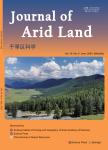Livestock induces strong spatial heterogeneity of soil CO2, N2O and CH4 emissions within a semi-arid sylvo-pastoral landscape in West Africa
Livestock induces strong spatial heterogeneity of soil CO_2, N_2O and CH_4 emissions within a semi-arid sylvo-pastoral landscape in West Africa作者机构:CIRAD-UMR Selmet Campus International Baillarguet Montpellier 34398 France DP PPZS ISRA-LNERV BP 2057 Dakar Hann Senegal Laboratoire d'Aerologie-OMP Universite Paul Sabatier 14 Avenue Edouard Belin Toulouse 31400 France Geosciences Environnement Toulouse UMR 5563 & UR 234 IRD Universite Paul Sabatier Avenue Edouard Belin 14 Toulouse 31400 France CILSS 03 BP 7049 Ouagadougou Burkina Faso AgroParisTech-UMR Eco&Sols 2 place Viala Montpellier SupAgro Montpellier 34060 France IRD-UMR Eco&Sols 2 place Viala Montpellier SupAgro Montpellier 34060 France
出 版 物:《Journal of Arid Land》 (干旱区科学(英文版))
年 卷 期:2017年第9卷第2期
页 面:210-221页
核心收录:
学科分类:0710[理学-生物学] 0830[工学-环境科学与工程(可授工学、理学、农学学位)] 0709[理学-地质学] 07[理学] 0708[理学-地球物理学] 0815[工学-水利工程] 0705[理学-地理学] 0713[理学-生态学]
基 金:funded by the Islamic Development Bank(the Merit Scholarship Program for High Technology) the European Union(the FP7-KBBE-2010 Animal Change Project)
主 题:greenhouse gases soil surface water livestock landscape Senegal
摘 要:Greenhouse gas (GHG) emissions from the surface soils and surface water receiving animal excreta may be important components of the GHG balance of terrestrial ecosystems, but the associated processes are poorly documented in tropical environments, especially in tropical arid and semi-arid areas. A typical sylvo-pastoral landscape in the semi-arid zone of Senegal, West Africa, was investigated in this study. The study area (706 km2 of managed pastoral land) was a circular zone with a radius of 15 km centered on a borehole used to water livestock. The landscape supports a stocking rate ranging from 0.11 to 0.39 tropical livestock units per hectare depending on the seasonal movements of the livestock. Six landscape units were investigated (land in the vicinity of the borehole, natural ponds, natural rangelands, forest plantations, settlements, and enclosed plots). Carbon dioxide (CO2), nitrous oxide (N2O) and methane (CH4) fluxes were measured with static chambers set up at 13 sites covering the six landscape units, and the 13 sites are assumed to be representative of the spatial heterogeneity of the emissions. A total of 216 fluxes were measured during the one-year study period (May 2014 to April 2015). At the landscape level, soils and surface water emitted an average 19.8 t C-CO2 eq/(hm2.a) (CO2: 82%, N2O: 15%, and CH4: 3%), but detailed results revealed notable spatial heterogeneity of GHG emissions. CO2 fluxes ranged from 1148.2 (±91.6) mg/(m2.d) in rangelands to 97,980.2 (±4,861.7) mg/(m2.d) in surface water in the vicinity of the borehole. N2O fluxes ranged from 0.6 (±0.1) mg/(m2.d) in forest plantations to 22.6 (±10.8) mg/(m2.d) in the vicinity of the borehole. CH4 fluxes ranged from -3.2 (±0.3) mg/(m2.d) in forest plantations to 8788.5 (±2295.9) mg/(m2.d) from surface water in the vicinity of the borehole. This study identified GHG emission "hot spots" in the landscape. Emissions from the surface soils were significantly higher in the landscape units most freq



